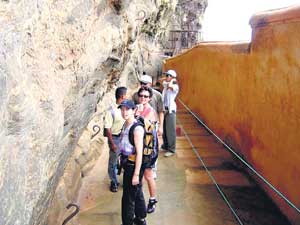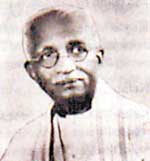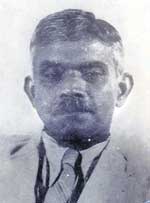Sri Lankan takes over Archaeology Department
In the 1920s, a self-taught village schoolmaster teaching at Udugampola Bilingual School won a scholarship to study archaeology in India. He came back and joined the Archaeological Department as an Epigraphical Assistant in 1926. He obtained a PhD from the University of Leyden in 1936. Four years later, on October 1, 1940, he became the first Sri Lankan Commissioner of Archaeology. His name was Senerat Paranavitana (1896-1972).
His work in deciphering and interpreting ancient inscriptions found in the ancient kingdoms in Sri Lanka has been recognised as of very high quality. Due to his devotion and keen interest, remarkable achievements were recorded in the Department in relation to excavations in Sigiriya, Anuradhapura, Kotte, Dedigama and other ruined cities. His knowledge of the history of Sri Lanka, his skill and bold outlook made the Department render a great service.
 |
| Visitors at the mirror wall, Sigiriya, where stanzas were
written by vistors in the ancient times |
Among the ancient monuments, Sigiriya was of special interest to
Dr. Paranavitana who, in a provocative lecture to the Royal Asiatic Society theorised that it was the abode of a God-King. He deciphered over 350 stanzas written on the wall and published 'Sigiri Graffiti' (1956). Among other highly acclaimed publications are 'The Stupa in Ceylon' (1946) and 'Art & Architecture of Ceylon: The Polonnaruwa Period' (1954).
After retirement,
Dr. Paranavitana was appointed Professor of Archaeology at the University of Ceylon, Peradeniya (1957-61). He was co-editor of two parts of the University of Ceylon's 'History of Ceylon.' 'A Concise History of Ceylon' (1961) compiled by Nicholas and Paranavitana is a handy publication on the country's history. |



